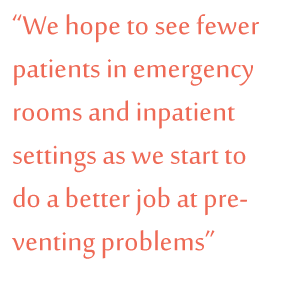Law’s impact forever changes healthcare financing and access to care
With the U.S. Supreme Court’s landmark decision to allow most of the Affordable Care Act (ACA) to stand, tens of millions of patients are about to acquire health insurance in 2014, some for the first time. This represents a monumental change in our nation’s approach to healthcare delivery, and it will forever change the financing of medical care. But with a shortage of primary care physicians (PCPs), many doctors are uncertain about its initial effect on primary care and the future of it.
Glen Stream, MD, MBI, FAAFP, president of
 the American Academy of Family Physicians (AAFP), agrees.
the American Academy of Family Physicians (AAFP), agrees.
This has been shown to be the case in Massachusetts, where a study by the Blue Cross Blue Shield of Massachusetts Foundation found that the use of emergency rooms for nonemergency reasons declined 4% from 2006 to 2010 (see Massachusetts case study).
Stream knows that primary care is already at capacity in many parts of the United States, especially family medicine. An AAFP study in 2000 found that a national shortfall of 3,900 family medicine practitioners will occur by 2020. The Association of American Medical Colleges (AAMC) estimates a national shortfall of more than 90,000 physicians across all specialties by 2020.
“By 2014 [when the new laws fully take effect], thousands of family practitioners aren’t going to suddenly appear,” Stream says. But an estimated 32 million new patients will.
The increased demand could bring new attention to solving the problem, Stream adds. The AAFP advocates for issues such as how to get more medical students interested in family practice and help them cope with the lower salaries while facing burdensome debt and achieve higher reimbursement, he says.
Richard M. Dupee, MD, chief of the geriatrics service at Tufts Medical Center in Boston and governor of the American College of Physicians’ Massachusetts chapter, sees the aging workforce as another major problem.
“Some older physicians are retiring rather than bothering with the requirements to adopt electronic medical records, and they are not being replaced by younger ones,” he says. “In rural areas, there are fewer of the academic hospital-owned clinics to take up the slack.”
Massachusetts is in the process of trying to fix another disincentive to primary care careers: low reimbursement. A bill is pending in the state legislature to raise payments. Nationally, the Centers for Medicare and Medicaid Services recently announced plans to give family physicians, internists, and others providing primary care a raise, too. But the trend for doctor reimbursements has been going down, and it may likely get worse for some.
“If reimbursement is fair, physicians with capacity will welcome [newly insured patients], but if it is not adequate, they will not,” Dupee says. “Most seasoned physicians in their 50s or 60s are already maxed out. They can’t absorb more volume without more money to cover the extra staff they will need.”
ADVOCACY
The AAMC notes that U.S. medical schools have complied with requests to boost class sizes by 30% time over the past 6 years, but the overall supply of U.S. physicians cannot expand unless Congress increases the number of federally funded residency training positions, a number that has been frozen since 1997.
“The AAMC is working hard to revisit this freeze,” says Christiane Mitchell, director of federal affairs. “Staying where we are will leave U.S. medical school graduates without a training position. This is an immediate issue.”
She notes that there is no real policy justification for the freeze; it was merely a victim of budget-cutting. The possibility of further federal cuts also has been raised.
“Medical school graduates need a place to train. Without one, it limits their options and may discourage the best and the brightest from choosing medicine as a career,” she says.


